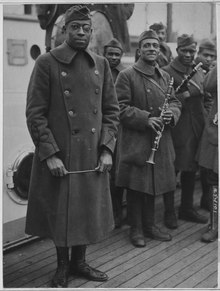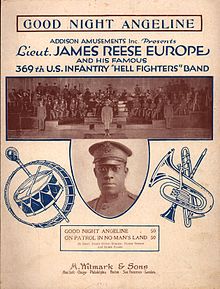James Reese Europe
James Reese Europe (born February 22, 1881 in Mobile , Alabama , † May 9, 1919 in Boston , Massachusetts) was an American band leader and composer of ragtime and early jazz .
Live and act
Reese moved the family to Washington, DC when he was 10 years old . Both parents were musicians. He learned violin and piano and took lessons in Washington from Enrico Hurlei, the assistant director of the Marine Corps' band. At 14 he even won second prize in a composition competition (first prize went to his sister Mary).
At the age of 22 (1904) he went to New York, where he played piano in bars and continued his music studies. In 1907 he was musical director in musicals by Bob Cole and J. Rosamond and James Weldon Johnson ( Shoe Fly Regiment ) and Bert Williams ( Mr. Lode of Coal ). In 1910 he founded the Clef Club , an organization for African-American musicians with its own building, part union and agency, part orchestra. They arranged musicians for the parties of the New York society - solely for entertainment (at that time many musicians still had to work as waiters on the side). In 1912 the Clef Club Orchestra gave a concert at Carnegie Hall for a music school for African American people. In the orchestra, 125 musicians (later sometimes even 150) played on partly exotic instruments, according to a review of the New York Times from 1914 orchestral arranged “plantation melodies and spirituals.” This was also the first appearance of a band with jazz-like music in Carnegie Hall (12 years before Paul Whiteman and George Gershwin in the Aeolian Hall and 38 years before Benny Goodman's Carnegie Hall Concert ), even if they still played mostly ragtime, i.e. through-composed music. They were so successful that they gave more concerts there in the following years.
The Reese Society Orchestra (with arranger Ford Dabney ) became popular nationwide from 1912 as a backing band for the dancers Vernon and Irene Castle , who made ragtime dances such as the foxtrot they created "socially acceptable " , which are otherwise frowned upon by the white middle class . They played in the dance school of the Castles Castle House and in their restaurant Sans Souci and in 1914 in the Palace and Victoria Theaters , the then leading vaudeville theaters. At that time he also added the saxophone as an instrument to the orchestra, which previously played an exotic outsider role. Between 1913 and 1914 they made recordings for RCA Victor , which are considered to be one of the earliest recordings of the "hot" ragtime style on the East Coast and were the first ever recordings by African American musicians for a large American record company. In 1915 Reese separated from the Castles, who continued with Ford Dabney as musical director.
During the First World War , Reese served as a lieutenant in the 369th Infantry Regiment, the "Harlem Hellfighters", and he also directed their military band The Hellfighters Band , for which he was able to recruit colored musicians from all over the US Army, for which he traveled to Puerto Rico . The Hellfighters included a. trumpeter Russell Smith; and trombonist Herb Flemming . They arrived in France on the New Year of 1918 as the first African American combat unit on the theater of war. From February to March 1918, they covered over 2,000 miles in France to look after the troops, but were also on duty (he was injured in a poison gas attack in June and hospitalized). In addition to marches - for example by Sousa - they also played ragtime or early jazz (" syncopated " music, in numbers such as " Memphis Blues "), which they made popular in France. When asked about his secret by the leaders of European military bands, he not only mentioned the “wildly syncopating” rhythms and the use of black “ folk material ”, but also the “ jazz spasms” especially of the trombones and the efforts of his musicians to constantly produce new, unusual tones.
In February 1919 the band returned to the United States with a triumphant Victory Parade in New York, in which the band led the Hellfighters as they moved into Harlem . Reese made recordings there for Pathé Records, partly as accompaniment for the singer Noble Sissle (who was already in Reese's Society Orchestra and also played the violin), which showed significantly more blues numbers and influences from the original Dixieland Jass Band ( Clarinet Marmalade ). Some of the earliest recordings of Dixieland classics such as St. Louis Blues , Memphis Blues , The Darktown Strutters' Ball , as well as Reese's On Patrol in No Man's Land , with grenade strikes and others, were made here Sounds of war on the drums. Together with Sissle and Eubie Blake he composed Goodnight Angeline in 1919 .
That same year, Reese Mitten was stabbed to death on a successful nationwide tour by one of his band members (a drummer) who did not like Reese's strict leadership style. A vein in his neck was injured and he bled to death on the way to the hospital. He was honored with a funeral parade in New York and buried in Arlington National Cemetery. The remainder of the band's tour was led by Noble Sissle and Eubie Blake.
literature
- F. Reid Badger: " A Life in Ragtime: A Biography of James Reese Europe ". Oxford University Press 1995, ISBN 0-19-506044-X .
- ders. " James Reese Europe and the Prehistory of Jazz ". American Music Vol. 7, 1989, pp. 48-67.
Web links
- Tom Morgan biography
- Biography University of Michigan
- Reese on the Ken Burns film website
- The Society Orchestra of Europe at Redhotjazz
- Floyd Levin at Redhotjazz for the Hellfighters Band, from his book "Classic Jazz"
- Reese in World War I, from the Ken Burns film website
Individual evidence
- ↑ For the concert, the racial segregated seating arrangements in Carnegie Hall were temporarily canceled
- ^ Which is supposed to be based on the Memphis Blues.
- ↑ Objections of the union that the castles only had to play with white orchestras, circumvented them by taking it from the orchestra pit onto the stage
- ↑ Redhotjazz website
- ↑ quoted from the website for the Ken Burns TV series about jazz
| personal data | |
|---|---|
| SURNAME | Europe, James Reese |
| ALTERNATIVE NAMES | Reese Europe, James |
| BRIEF DESCRIPTION | American ragtime and jazz band leader |
| DATE OF BIRTH | February 22, 1881 |
| PLACE OF BIRTH | Mobile , Alabama |
| DATE OF DEATH | May 9, 1919 |
| Place of death | Boston , Massachusetts |

